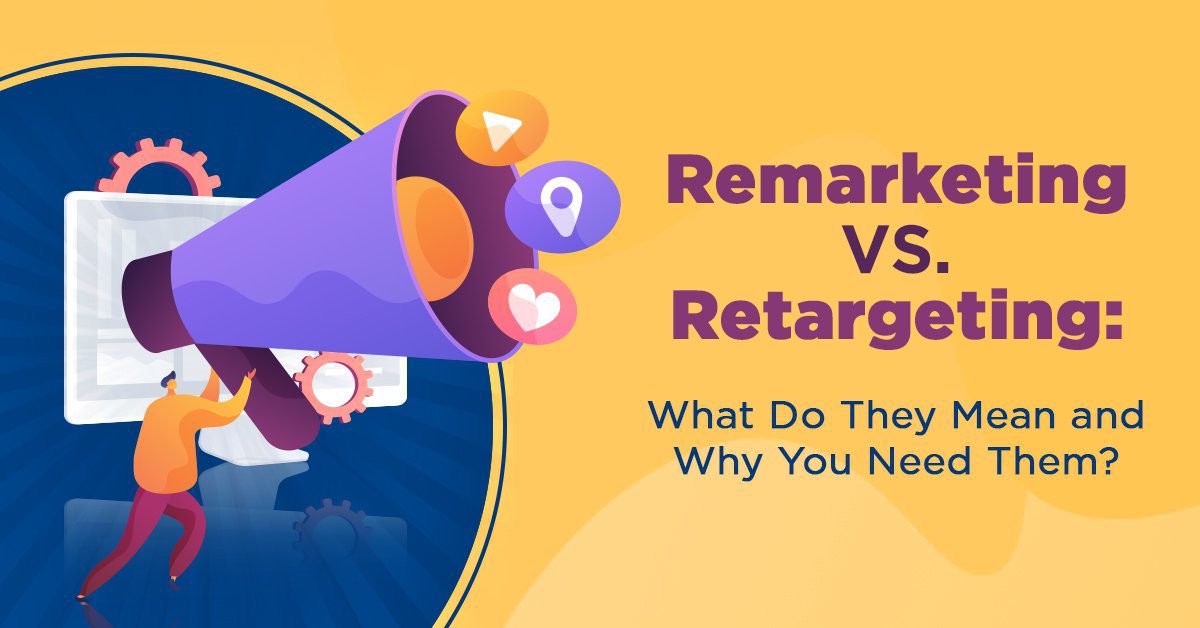Introduction
In the world of digital marketing, the terms “remarketing” and “retargeting” are often used interchangeably, leading to some confusion. While they share a common goal of re-engaging potential customers who have shown interest in your products or services, there are subtle differences that can significantly impact your marketing strategy. This blog will help you understand the distinctions and how small businesses can leverage both techniques effectively.
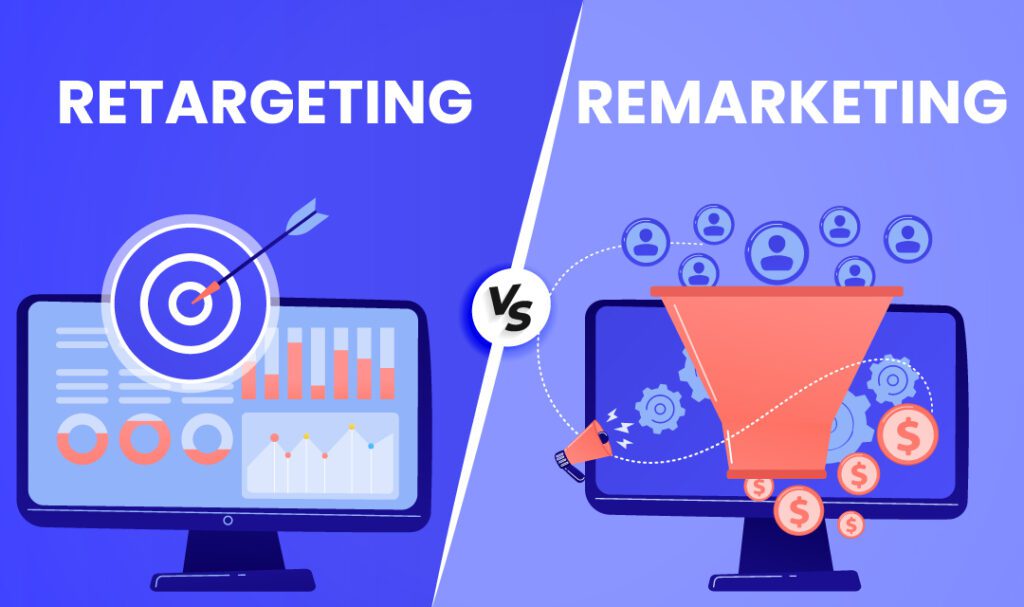
Remarketing and Retargeting: How Are They Different?
When you venture into the realm of distinguishing between remarketing and retargeting, you might discover that the landscape is rife with conflicting information. It’s a common scenario that could leave you more perplexed than when you embarked on your quest for clarity.
The confusion stems from the fact that different sources often use these terms in various ways. Some contend that remarketing and retargeting are entirely synonymous, while others argue that they represent distinct strategies pursuing similar objectives. There’s even a group that posits these as separate marketing techniques, each with its own unique goals.
In essence, you’ll find that the term ‘remarketing‘ is sometimes employed as an overarching concept that encompasses both remarketing and retargeting. Part of this ambiguity can be attributed to Google itself, whose Google Ads remarketing tools encompass both remarketing and retargeting strategies. Over time, this has blurred the boundaries between the definitions of these terms.”
To simplify the matter, let’s provide clear and common definitions for each strategy:
Remarketing is a term that pertains to utilizing email to re-engage with your existing customers or an audience that has previously shown interest in or conducted business with your brand.
Retargeting, on the other hand, refers to the delivery of paid online and display ads based on a user’s activity on your website or social media profiles.
Regarding their marketing goals, retargeting is primarily focused on guiding past visitors to your website or social media platforms back to your site to convert them into customers. Conversely, remarketing is more about re-engaging your existing customers and maximizing their lifetime value.
An easy way to distinguish the uses of these tactics is to consider that retargeting is concentrated on moving your audience, who haven’t become customers yet, along the path to making a purchase. In contrast, remarketing centers on reconnecting with individuals who have previously made a purchase from you or have joined your email list.
In terms of similarities, both remarketing and retargeting are lead nurturing tactics aimed at supporting a comprehensive customer lifecycle marketing plan. By strategically employing these tactics, you can target audiences already familiar with your brand, engage with those most likely to convert, and establish long-term brand recognition and awareness.
Remarketing and retargeting leverage the incredible opportunities presented by the ability to collect and analyze user activity data online. These strategies transcend simple advertising, where your brand is exposed in the hope that it sticks with some people. They also go beyond targeted advertising, where you’ve identified a specific target market and advertised where you expect them to spend time.
The strength of both remarketing and retargeting lies in the fact that you’re not just reaching out to your target demographic; you’re doing so in a highly customized way that caters to each individual’s position in the sales funnel, precisely when they are most receptive to your message.
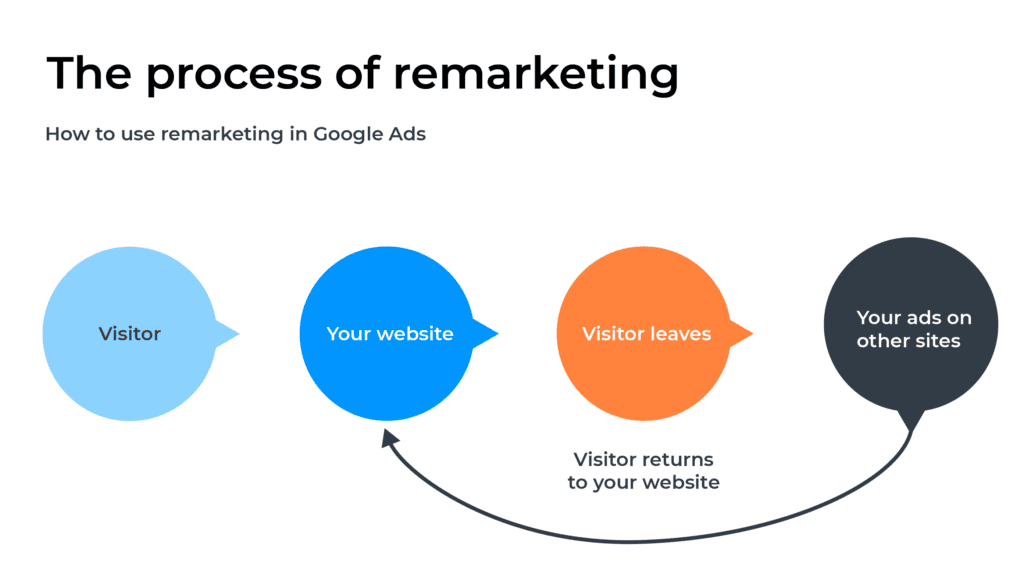
What Is Remarketing?
Now that we’ve delved into the shared characteristics and distinctions between remarketing and retargeting, let’s explore each term in greater depth. To clarify, we are focusing on the definition of remarketing that specifically relates to re-engaging customers through email, rather than using it as an umbrella term that encompasses both remarketing and retargeting efforts.
Chances are, you’re already well-acquainted with email marketing as a local business. It’s a cost-effective and results-oriented marketing strategy that has gained widespread recognition. In fact, a substantial 64% of small businesses rely on email marketing to connect with their customers. What’s more, a significant four out of five marketers express a preference for email marketing over social media marketing.
The effectiveness of email marketing is evident, but what if there were a way to elevate your email marketing efforts? What if you could harness the potential of email to re-engage your customers with tailored messages that align with their specific position along the path to making a purchase?
Remarketing tactics leverage the valuable data collected from user activity to your advantage. By tracking users’ prior purchase behavior or actions on your website, you can employ this strategy to re-engage with past or current customers, reigniting their interest and involvement.
Examples of remarketing emails encompass:
- Reaching out to users who abandoned a shopping cart, encouraging them to complete their purchase.
- Promoting products related to a customer’s past purchases, offering them relevant recommendations based on their history.
- Sending follow-up emails after a purchase to express appreciation and provide post-purchase support or cross-sell opportunities.
- Reconnecting with users by reminding them of items they’ve added to their wishlist, prompting them to revisit and possibly make the purchase.
Remarketing, as opposed to retargeting, necessitates having an email list. Nevertheless, by harnessing the power of the data you’ve collected, remarketing can significantly enhance the profitability of your existing email list, fostering lasting customer relationships and increasing customer lifetime value.
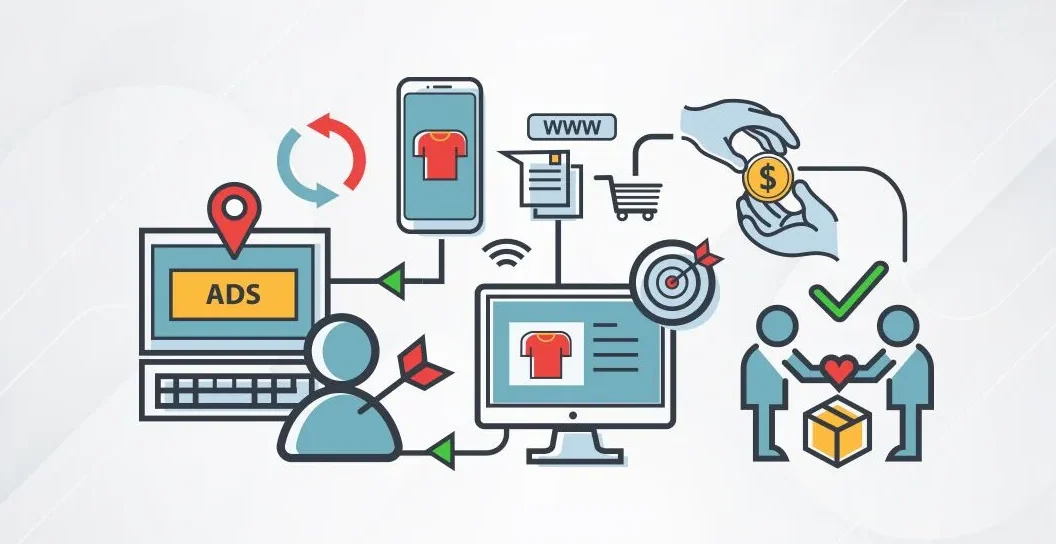
How Does Remarketing Work?
In building your remarketing campaigns, there are two fundamental tools at your disposal: pixels and lists.
Pixels for Remarketing: These are snippets of code that serve as tracking mechanisms, following a user’s journey through your website to provide valuable insights into their shopping behaviors. The data collected through pixels can be used to craft tailored emails for different users. For instance, pixels can identify customers who have items in their wishlist, enabling you to send them strategic reminders about the products they’re contemplating purchasing.
Remarketing Lists: These are structured lists of the customers who visit your website and where they stand in the purchase process. You have the flexibility to categorize users into distinct segments, such as:
- Customers who have abandoned a shopping cart: Users who added items to their cart but did not complete the purchase.
- First-time purchasers: Individuals who have just made their first transaction with your business.
- Frequent customers: Repeat buyers who engage with your brand regularly.
- Customers with an expiring subscription: Those with subscriptions that are nearing their renewal or expiration dates.
- Visitors with items in their wishlist or favorites: Users who have saved products for future consideration.
For each group within these lists, you can customize and send different emails tailored to their specific site activities. This personalized approach enhances the chances of re-engaging customers and ultimately converting them.
Let’s explore the types of emails that you could send to each of the customer categories mentioned:
- Customers that have abandoned a shopping cart: Send a cart reminder email to gently nudge them to complete their purchase, possibly including an incentive or discount.
- First-time purchases: A simple thank you note email expressing appreciation for their initial purchase and inviting them to explore other products or services.
- Frequent customers: Share promotions, related products, or upselling opportunities to encourage repeat purchases and brand loyalty.
- Customers with an expiring subscription: Send a subscription reminder email, notifying them of the approaching expiration and presenting renewal options or incentives to extend their subscription.
- Visitors with items in their wishlist or favorites: Alert them about a sale or special offer related to the items in their wishlist, enticing them to make a purchase.
Your remarketing campaign can be fully automated, ensuring that emails are sent to the relevant users at the opportune moments in their customer journey.
However, it’s vital to adhere to email remarketing best practices when implementing this strategy. Missteps in your approach could potentially alienate customers rather than rekindle their connection with your brand.
When attempting to reconnect with previous customers, simplicity and compelling incentives are key. Yet, it’s important to strike a balance and avoid bombarding customers with excessive emails, as this can lead to irritation. Instead of sending emails indiscriminately, develop a thoughtful campaign strategy that strategically reminds customers of your brand at pivotal points in their customer journey.
Lastly, while it may be tempting to create complex email designs, it’s often best to keep your remarketing emails simple. Clean and straightforward emails are often just as effective, if not more so, than those with intricate designs, as they prioritize clarity and engagement.
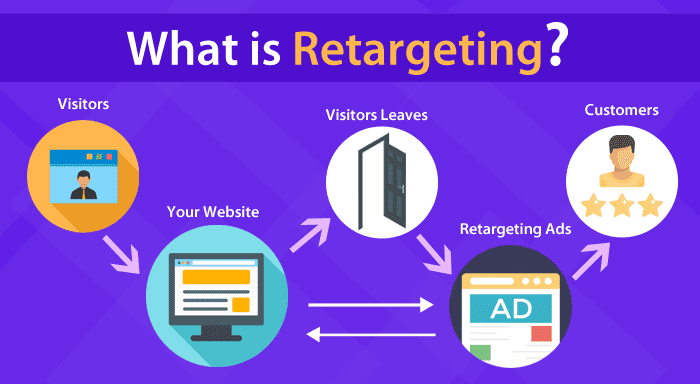
What Is Retargeting?
Remarketing and retargeting, although related, have distinct focuses. Remarketing primarily engages with past or existing customers through email, while retargeting is aimed at identifying individuals who are familiar with your brand but haven’t made a purchase. In retargeting, digital ads are strategically displayed to these warm leads while they browse other websites.
This strategy revolves around targeting people who have previously visited your website or social media profiles with online or display ads based on their online behavior. The process involves tracking users‘ activities using pixels when they visit your site and then presenting ads tailored specifically to them. The remarkable aspect of retargeting is that the ads you display to these users appear on other websites, allowing you to reach them even when they have ventured far from your brand’s website.
In essence, retargeting capitalizes on the recognition and interest that users have already shown in your brand, making it a valuable tool for guiding potential customers back to your website and ultimately encouraging conversions.
Indeed, retargeting is a highly potent tool in the world of digital marketing. It allows you to advertise to individuals who are already familiar with your brand, even when they are visiting countless other websites.
What makes retargeting particularly powerful is that it doesn’t necessitate capturing a potential customer’s email address or multiple site visits. If you’ve ever visited a website and then noticed an advertisement for that same brand while scrolling through your Facebook feed or browsing the web on different sites, you’ve directly encountered retargeting. This strategy is designed to keep your brand fresh in the minds of potential customers and guide them back to your site, increasing the likelihood of conversions.
Key Differences
1. Medium and Approach:
- Remarketing is primarily email-based, focusing on direct communication with past customers or subscribers.
- Retargeting is display advertising, utilizing banner ads, social media ads, and other ad formats to re-engage website visitors.
2. Audience Definition:
- Remarketing involves creating lists of specific individuals (email subscribers, past customers) and sending them personalized messages.
- Retargeting targets a broader audience of website visitors and displays ads to those who have visited certain web pages.
3. Timing:
- Remarketing can be initiated at any time and isn’t necessarily dependent on immediate past interactions.
- Retargeting is typically triggered when users leave your website without completing a specific action.
How Does Retargeting Work?
Retargeting employs pixels, much like remarketing, but with an expanded scope. These pixels not only track users’ on-site activities but also monitor their off-site behavior. While remarketing centers on your audience’s actions on your own website, retargeting extends its reach to display ads to your users when they are elsewhere on the web. This strategic approach ensures that your customers continually remember your brand and increases the likelihood of them thinking about your brand when they are ready to make a purchase relevant to what you offer.
To facilitate retargeting, ad exchange networks come into play. The Google Display Network stands as the largest among these exchange networks. It offers the capability to reach your users while they are browsing an extensive array of websites, apps, and Google-owned platforms like YouTube. Another substantial network is Facebook’s Audience Network, enabling you to display ads to your audience on some of the world’s most popular social media platforms, including Instagram, WhatsApp, and Messenger. These networks provide a vast reach, ensuring that your retargeted ads are seen by users across a diverse digital landscape.
Regardless of the ad networks you select, when you sign up, you will receive a retargeting pixel that is specifically designed for your website. These pixels consist of small lines of code that continue to monitor your visitors’ activities even after they have left your site. When they subsequently browse a website that is part of the ad network you’ve joined, the network can identify which types of ads to display based on the user’s browsing history.
While digital ads can be effective marketing tools, they do come at a cost. The most common pricing models are cost-per-mille (CPM), where you pay for the number of times your ad is displayed, and pay-per-click (PPC), where you pay for the number of times your ad is clicked on.
Retargeting can be instrumental in maximizing the return on investment (ROI) from your ad campaigns. This is because your ads are shown to individuals who are already familiar with your brand, having visited your site or social media profiles. By targeting this warm audience, you increase the likelihood of conversion, making your advertising expenditure more cost-effective and driving better results.
Is Remarketing or Retargeting Better for Local Businesses?
Small business marketing campaigns don’t adhere to a one-size-fits-all approach, as the optimal strategy for your brand hinges on your specific goals. Nevertheless, both remarketing and retargeting strategies serve as valuable tools for local businesses, helping to re-engage existing customers and cultivate new ones.
For local businesses, email marketing proves to be an ideal avenue for nurturing leads and driving conversions. Through email remarketing campaigns, you can tailor your email communications to your email list, taking into account each customer’s actions and their position in the sales funnel. This personalized approach is particularly effective in the local context, where building strong customer relationships and encouraging repeat business are paramount.
Absolutely, retargeting is a potent asset for small businesses, offering cost-efficiency, effective targeting of warm leads, and the ability to create customized ads based on user activity.
Local businesses gain an extra advantage by merging retargeting with geotargeting. Geotargeting narrows down the scope of your ads to individuals within a specified geographic area who match your target demographic. This combination ensures that your advertising budget is judiciously spent, as your ads are exclusively showcased to the most qualified and relevant leads within your local vicinity. This synergy maximizes the impact of your advertising efforts and enhances your ability to convert potential customers into loyal patrons.
Conclusion
In conclusion, understanding the subtle yet crucial disparity between remarketing and retargeting is a game-changer for small businesses. By harnessing these distinct strategies, local enterprises can revitalize customer relationships, reach warm leads, and optimize their advertising budget. Remarketing, with its personalized email approach, strengthens customer bonds, while retargeting extends its reach to potential customers across the web. The synergy of these tactics, when coupled with geotargeting, ensures that your marketing efforts hit the mark and provide the highest possible return on investment. So, as a small business, the difference between remarketing and retargeting may be just what you need to elevate your marketing game and thrive in a competitive landscape.


